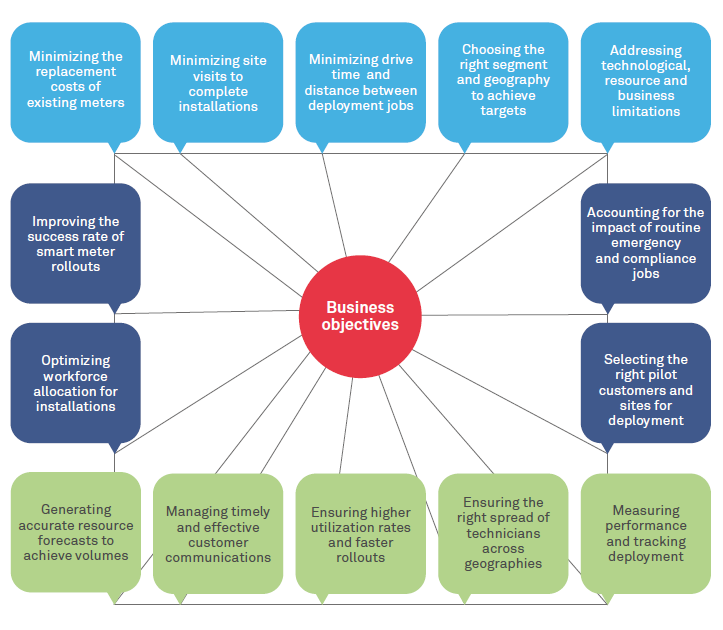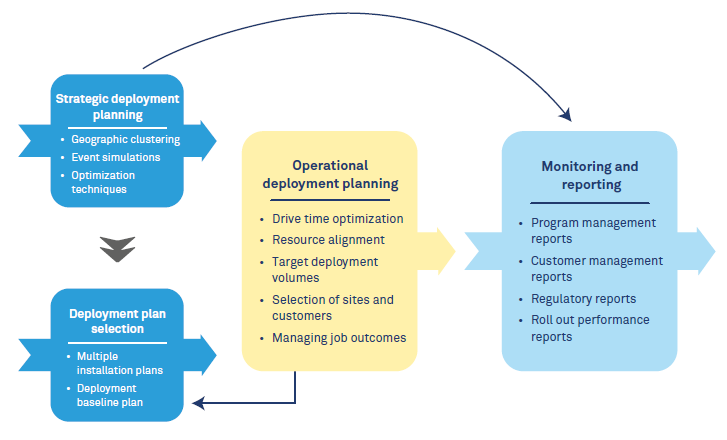Utilities in the United Kingdom are going through a transformational phase with Smart Meter implementation. Ofgem, the government regulator for the electricity and downstream natural gas markets in Great Britain, mandates that energy suppliers install smart metering systems in Great Britain by the end of 20201.
About 53 million smart meters must be deployed across Great Britain by the end of 20202.
For a supplier, the ramp up of volumes to be installed, or exchanged annually during smart rollout, is about 5 to 10 times their current deployment numbers.
They face significant challenges like high cost of deployment, lack of business process and field activities efficiency, uncertainty around customer churn and customer acceptance, resource and technology limitations, among others.
Business case estimates that smart meter deployment will deliver benefits of £18.6 Billion, at an estimated total cost of £11 Billion across Great Britain. Costs include meter installation, operations, IT systems, governance, administration etc. and benefits can be attributed to the consumer (savings from reduced
consumption), supplier (unnecessary site visits, reduced complaints, queries) etc. Not all of these costs and benefits are relevant to suppliers, as costs and benefits are distributed unevenly among the major stakeholders of the smart metering implementation plan.
What is critical to a supplier is a smart strategy with a single business objective of minimizing the cost of deployment while maximizing the benefits achievable.
The rollout objectives
As a part of deployment planning, suppliers need to address the different costs associated with field technician resources, non-deployment time, other urgent field work, multiple visits to finish each install, meter removal costs, resource
spread, regulatory penalty, etc., and seek benefits like customer satisfaction, lessen churn likelihood, debt propensity, etc., to name a few (figure 1).

Figure 1: Business objectives of the deployment
‘Smart’ deployment strategy
Considering the complexities and large investments involved in smart meter rollout programs, suppliers needs to be 'smart' in how they plan the rollout, monitor progress, select customers, manage communications, and forecast resources. The challenge is in completing the rollout within the given time and cost while achieving acceptance from customers.
To eliminate the risk of cost and time overruns suppliers should leverage analytics to guide smart meter rollouts, from planning through implementation. They should use advanced analytics techniques to produce the deployment plan while applying resource limitations, technological constraints, business rules and other assumptions that drive productivity. Use of analytics will help target the right geographies, identify the right customers, maximize utilization, optimize routes and workforce allocation, and plan and monitor rollouts to bolster the success rates of smart meter installations.
Analytics: The efficiency enabler
Analytics-led solution enables production and delivery of a continually optimized plan to maximize productivity and utilization of resources while minimizing the risk of non-delivery.
The solution overview depicted (figure 2) illustrates two planning aspects:

Figure 2: Solution overview for smart meter deployment planning
Geography-based clustering, which is driven by the proximity of customers, reduces the average distance to cover within an area, helping reduce the average travel time between deployment jobs.
Based on its attributes, a selected area can have different productivity levels. To drive utilization accurately, it is important to simulate events of the daily installation process and estimate its efficiency. Considerations like access rates, job success rates, constraints applicable, availability of resources etc., can be accounted. Event simulations enable ‘what-if’ analyses on changes in resource levels to determine impact on the number of visits and resultant installations.
Operations research techniques will prescribe where and how much of smart meter deployment to plan for the given deployment deadline. For the selected area, deployment profile with the right operatives to be assigned and resulting number of visits and installs across time periods can be understood to achieve the goal while respecting limitations.
Business can produce multiple installation plans by varying factors such as resource levels, eligibility rules, access rates, etc., to enable comparison and scenario analysis. It can select an ideal deployment plan to follow by performing cost benefit analysis.
Operational deployment planning is essential to plan and manage work by selecting the most appropriate customers and sites to engage with, to support the delivery plan. This highlights the ability to implement a deployment plan based on a set customer journey through high and low level planning, to trigger communications and achieve installations. Further, the factors required to produce the strategic deployment plan can be updated based on the operational experience.
Rolling out benefits
As the deployment numbers go up for suppliers, applying advanced analytics to implementation becomes relevant in solving logistical, technical, business and commercial challenges. It will help tackle the complexities involved in rollouts while maximizing the business impact. Scenario analysis and a proactive approach to deployment planning will help achieve the targets amidst stringent time and cost limitations.
End note
1 & 2 – https://www.gov.uk/government/publications/sm art-meter-roll-out-gb-cost-benefit-analysis
Tarkik Patel - Lead Consultant, Big Data Analytics, Wipro
Tarkik has over eight years experience in analytics consulting and implementations. He is a management graduate, immensely passionate about driving business impact through advanced analytics and decision science. He has well-established experience working in multiple projects and solutions in the area of big data analytics and business intelligence across industries like utilities, healthcare and automobiles in the UK and US markets. Presently, he is into delivering use cases around smart meter deployment analytics and customer analytics.